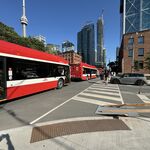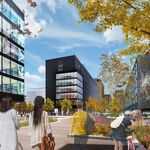M II A II R II K
Senior Member
The DRL is also neccessary for more GO terminuses and to relieve Union. And not be restricted to only having to transfer at Union.
I am starting to wonder if there is an economic case for converting Sheppard to LRT. Would the savings on the eventual Western extension offset the cost of conversion?
I read a quip on another thread that Sheppard should be extended using elevated. I assume this refers to the extension to STC. Although Sheppard may not be as barren as the Golden Mile and parts of Eglinton, it is not that far different.
I imagine 10 years ago Lastman thought only of burying it. 5 years ago Miller though only of building in-median. 2 years ago Ford did not think of any details about it at all.
Residents need to realize that the chances of the underground subway being built are close to zero. They then may seriously consider elevated as an improvement to the in-median proposal.
Yes they would. The conversion would be in the neighbourhood of $600 million. But that money will be more than made up for if the western Sheppard extension is done as at-grade LRT instead of a tunnelled subway extension. It's 3.4km from Senlac to Downsview Station. If you manage to save ~$175 million/km by building LRT instead of a subway extension, it ends up being even. Of course, if you can build the LRT for under $100 million/km, you'd be saving upwards of $250 million/km.
So in essence you'd be spending ~$600 million to save ~$850 million.
Built in the densest part of the city, the DRL will be the most expensive subway line that gets built in our lifetime. It will run from Pape where people already have a subway, through neighbourhoods with 10 minutes to downtown streetcar service, to other subway stations downtown. The commute times for people in these areas is already some of the lowest in the GTA so why would the DRL be important from a locals point of view?
Surface LRT is only possible on the 2.5 km stretch, from the western bank of West Don to Downsview. You would still have to tunnel to the eastern bank of West Don, likely build a new bridge, and then a terminal at Downsview will be needed.
Furthermore, the cost of conversion was quoted as $670 million, about 3 years ago. That's probably $750 million in today's dollars.
I expect that if we only take into account the Don Mills to Downsview stretch, then the LRT option will be somewhat more expensive than just extending the subway.
From Bathurst to Downsview, the LRT could be built for around $60 million/km. Compare that to the probably $350 million/km for a subway. $150 million vs $875 million. Again, pretty much a wash, depending on inflation.
But when you factor in any future extensions that can be done as at-grade LRT as opposed to subway, the numbers start to tip the scale more and more in favour of conversion.
Don't get me wrong, I think the SELRT is a dumb idea, but it looks like we're going to be stuck with it, so might as well make it as useful as possible. And in this case, that means spending money in the medium-term to save money in the long-term.
Technically, you are right; if the goal is to have a continuous line that extends east of Don Mills and west of Downsview, then LRT comes as the cheapest choice once the line is extended far enough.
Another question is whether this is the best choice from the network perspective. I would think that a combination of subway from Downsview to Kennedy, and LRT from Kennedy to Meadowvale, would be more effective in relieving other major bus routes in Scarborough.
Worst idea? The route between was on Don Mills Road (already planned for LRT) and Finch East from Yonge to Don Mills - which is the busiest bus route in the city. Surely Finch East would qualify for an LRT on it's own merits! Even if the route itself was a flop, it would have built LRT where it's very much needed.I always thought the idea of connecting the FWLRT and SELRT to be among the worst ideas I've ever heard. Up there with converting the Sheppard line and taking the SRT out of service for 5 years.
The bus route on Finch East between Yonge to Don Mills is only busy because people east of Don Mills has to travel through there to get to the Yonge subway terminus of Finch - imagine if Yonge ends at Steeles or beyond, and Sheppard ends at Kennedy, will people still choose to ride their way to Finch Stn. from say Warden/Finch? Probably not. There's nearly no established commercial nodes, except at Leslie. Finch West between Yonge and Keele doesn't fare much better either.Worst idea? The route between was on Don Mills Road (already planned for LRT) and Finch East from Yonge to Don Mills - which is the busiest bus route in the city. Surely Finch East would qualify for an LRT on it's own merits! Even if the route itself was a flop, it would have built LRT where it's very much needed.
If you're ever to connect FWLRT to SELRT (either by an extension of subway, or conversion to LRT), do it via Sheppard West.
That's a good point, the western and eastern sections of Toronto (Etobicoke/western North York vs. eastern North York/Scarborough) have very different demographics. There would likely be few people who'd travel from Victoria Park/Sheppard to Jane/Finch, and vice versa. The furthest they go would be Yonge, or York University (or the Spadina line).I don't really understand the expected demand for a "northern cross town," especially one that zigs and zags like a Finch-Sheppard one may. How many people want to travel across the top of the City? Maybe some people would find it convenient to skip Yonge or Spadina and go to the next subway line, but I suspect there would be very few station pairs were it wouldn't be quicker to use the ECLRT or ride around Union.




